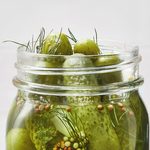From the Brewery to the Belly
How does barley become beer? Find out how the ancient art of brewing has been reduced to a simple science.
How Beer Began
The first beer was brewed around 5,000 B.C. in what is now Iraq and Egypt. Barley, the grain that still dominates beer brewing, was abundant in that region.
Over the years, almost every society has developed a way to make beer from local cereal grains: African tribes use sprouted corn, millet, and sorghum; Russians turn rye bread into a low-alcohol beer called kvass; the Chinese and Japanese use rice; and South and Central American Indians rely on corn to make their respective beers.
The A-B-C’s of Brewing
Many societies around the world continue to use their traditional methods to make beer, but most modern brewing is a scientific process.
It all begins with malting to convert grain starch into sugar that will ferment. The grain is sprouted in order to activate enzymes that will eventually turn the starch into sugar.
Next, the germination is stopped, the sprouts are removed, and the malted grain is prepared for mashing.
The malt is heated slowly to allow the enzymes to continue converting starch into a sugary broth called wort.
The grain is allowed to settle, and the wort is heated and filtered through it into the brewing kettles.
Hops, which are dried flowers from the hop vine, are added to the wort, and the mixture is boiled and then strained.
The wort is allowed to settle so that the protein can be removed; the clear liquid is then fermented with yeast and aged.
Eventually, yeast residue is skimmed off, and other ingredients are added to give beer a distinctive flavor, color, or aroma.
Different Strokes for Different Folks
Playing around with the ingredients produces a range of different flavours. Adding extra hops produces the British draft beer known as bitters. Ale, a more concentrated beer, uses a type of yeast that rises to the top. Stout is a bitter ale brewed from a dark malt.
The brewing method also influences the nutritional quality of beer. The cloudy German weisse bier retains many of the B vitamins found in brewer’s yeast, which have to be strained away to make clear beer. Native African beers remain unfiltered; as a result, they retain many of the nutrients found in the grains and roots and tubers that are their main ingredients. The type of yeast used by American and Canadian brewers contains selenium, an antioxidant mineral, and chromium, a mineral that aids carbohydrate metabolism.
One thing is certain, no matter the flavour we can all appreciate a well-brewed beer.



